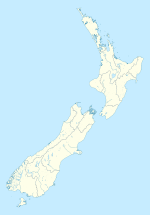Brothers Seamount

The Brothers Volcano is a Pacific Ocean submarine volcano in the Kermadec Arc, 340 kilometres north east of New Zealand's Whakaari/White Island. Within its oval outline, which measures 13 km by 8 km, it contains a 3 km wide caldera with walls 300-500 m high. It is three times bigger than the White Island.[1] A dacite (dacite lava's viscosity is in between rhyolite and andesite[1]) dome rises 350 m from the caldera floor (which lies 1850 m below sea level), with a smaller dome just to its northeast. The caldera walls and the larger dome host numerous hydrothermal vents, which send plumes of hot water 750 m up through the water column. It is the most hydrothermally active volcano known in the Kermadec Arc.[2] These hydrothermal vents are also known as hot springs and have created an 8 meter high field of "black smoker" chimneys.[3]These chimneys are created when the hydrothermal fluids hit the cold water and harden up.[1] The hydrothermal fluids are an energy source to many unique organisms like tubeworms and other bacteria.[3] The marine life and minerals found from these chimneys are beneficial to New Zealand's economy and biotechnology industry.[1]
The volcano was created by a subduction of the Pacific Plate under the Australian Plate.[1]
It is still unknown when the Brothers Volcano last erupted, but the crater walls tell us that its last eruption was so explosive that it caused the volcano to blow out a caldera.[3] A joint expedition by the United States, New Zealand and Germany mapped the volcano in detail in 2007.[4]
Monitoring
Submarine volcanoes are not monitored by any organization, but have become a central interest in current expeditions.[1]
See also
References
- ^ a b c d e f "Volcano Fact Sheet: Brothers Volcano" (PDF). Learning on the Loop. Retrieved 10-27-16.
{{cite web}}: Check date values in:|access-date=(help) - ^ "Brothers Volcano". GNS Science. 19 Dec 2009. Archived from the original on February 28, 2011. Retrieved 21 March 2010.
{{cite web}}: Unknown parameter|deadurl=ignored (|url-status=suggested) (help) - ^ a b c "Brothers Volcano". GNS Science. 11-25-13. Archived from the original on 2011-02-28. Retrieved 10-27-16.
{{cite web}}: Check date values in:|access-date=and|date=(help); Unknown parameter|deadurl=ignored (|url-status=suggested) (help) - ^ Gregory, Angela (17 August 2007). "Photo: Seabed volcano in all its glory". The New Zealand Herald. Retrieved 21 March 2010.
- de Ronde, C. E. J., Hannington, M. D., Stoffers, P., Wright, I. C., Ditchburn, R. G., Reyes, A. G., Baker, E. T., Massoth, G. J., Lupton, J. E., Walker, S. L., Greene, R. R., Soong, C. W. R., Ishibashi, J., Lebon, G. T., Bray, C. J., and Resing, J. A. (2005). Evolution of a Submarine Magmatic-Hydrothermal System: Brothers Volcano, Southern Kermadec Arc, New Zealand, Economic Geology, 100(6), 1097-1133. doi:10.2113/100.6.1097.
- "Brothers". Global Volcanism Program. Smithsonian Institution.

